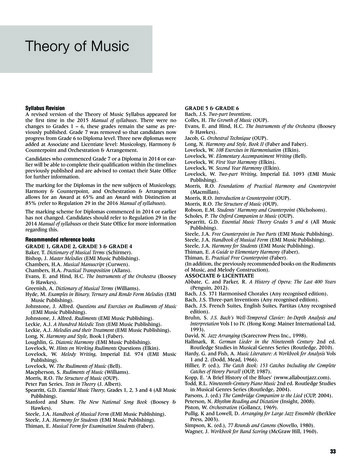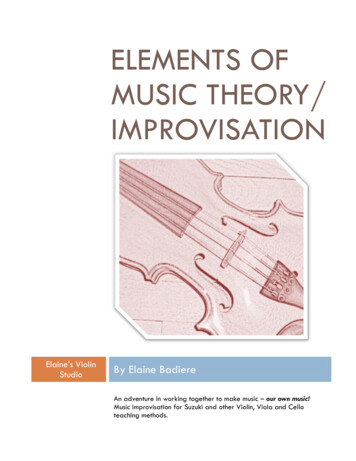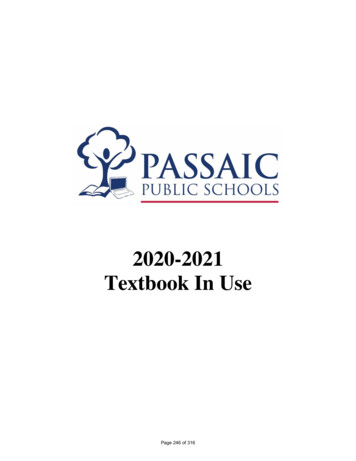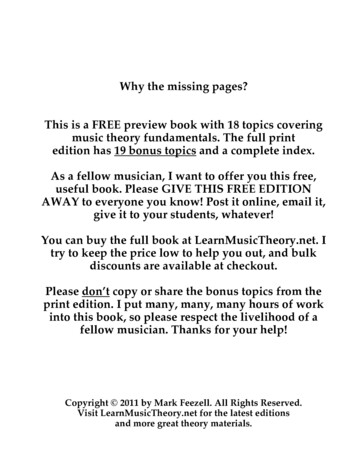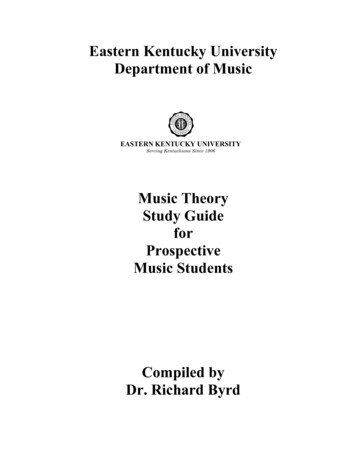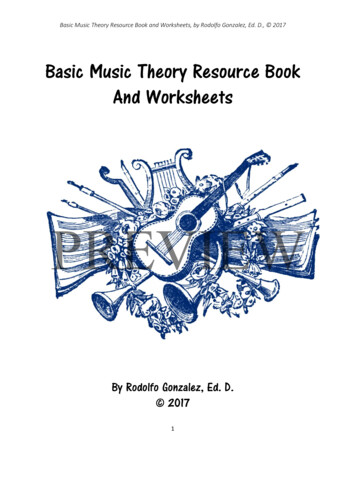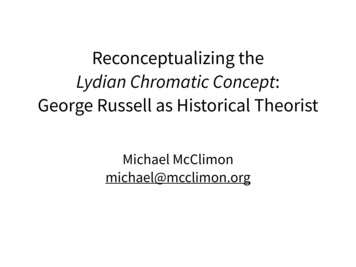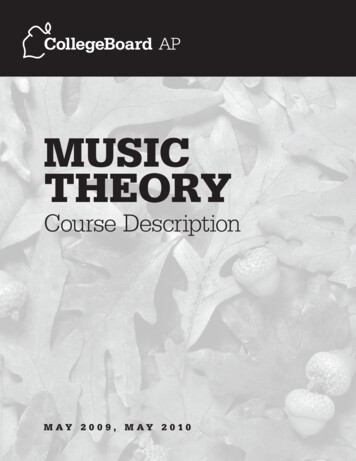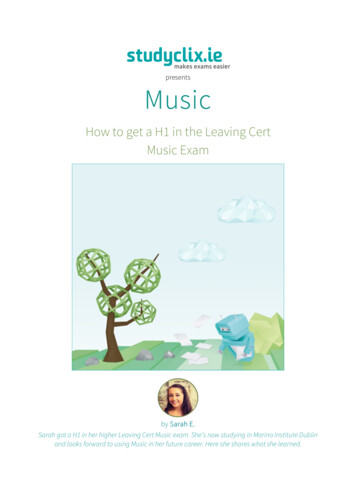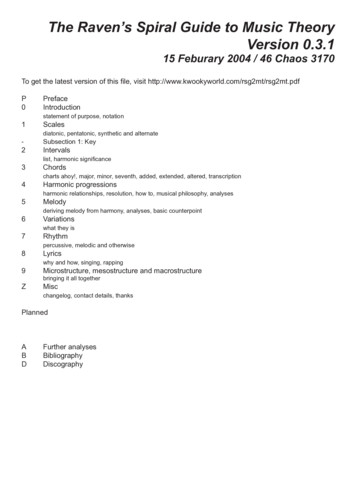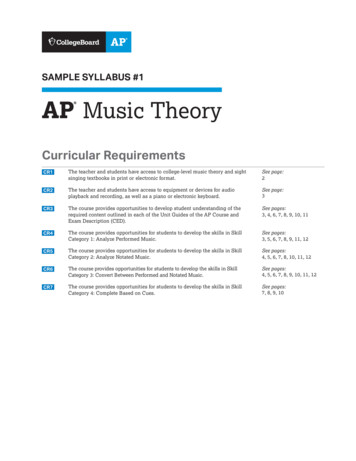
Transcription
SAMPLE SYLLABUS #1AP Music Theory Curricular RequirementsCR1The teacher and students have access to college-level music theory and sightsinging textbooks in print or electronic format.See page:2CR2The teacher and students have access to equipment or devices for audioplayback and recording, as well as a piano or electronic keyboard.See page:3CR3The course provides opportunities to develop student understanding of therequired content outlined in each of the Unit Guides of the AP Course andExam Description (CED).See pages:3, 4, 6, 7, 8, 9, 10, 11CR4The course provides opportunities for students to develop the skills in SkillCategory 1: Analyze Performed Music.See pages:3, 5, 6, 7, 8, 9, 11, 12CR5The course provides opportunities for students to develop the skills in SkillCategory 2: Analyze Notated Music.See pages:4, 5, 6, 7, 8, 10, 11, 12CR6The course provides opportunities for students to develop the skills in SkillCategory 3: Convert Between Performed and Notated Music.See pages:4, 5, 6, 7, 8, 9, 10, 11, 12CR7The course provides opportunities for students to develop the skills in SkillCategory 4: Complete Based on Cues.See pages:7, 8, 9, 10
Advanced PlacementMusic Theory Sample Syllabus #1Students must provide the following materials: a spiral staff-paper notebook, a two-inchthree-ring binder, loose-leaf paper, and pencils.Students will be provided with the following texts:1. Benward, Bruce, and Marilyn Saker. 2015. Music in Theory and Practice, Vol. 1. 9th ed.New York: McGraw-Hill. (abbreviated “MTP” in this document) CR12. Benjamin, Thomas E., Michael Horvit, and Robert S. Nelson. 2013. Music for SightSinging. 6th ed. Belmont, CA: Cengage Learning. CR1The teacher keeps a small library of the following texts used periodically as supplements:1. Kostka, Stefan, and Dorothy Payne. 2009. Tonal Harmony with an Introduction toTwentieth-Century Music. 7th ed. New York: McGraw Hill. Text and Workbook.2. Berkowitz, Sol, et al. A New Approach to Sight Singing. New York: W. W. Norton.3. Fux, Johann, trans. and ed. by Alfred Mann. The Study of Counterpoint: From JohannJoseph Fux’s Gradus ad Parnassum.Please set up your three-ring binder with division labels as follows:a. Spiral staff paper notebook for taking notesCR1The syllabus must citethe title, author, andpublication date of acollege-level music theorytextbook.ANDThe syllabus must citethe title, author, andpublication date of acollege-level sight-singingtextbook.b. Homework to be handed inc. Homework already gradedd. Sight-singing examplese. Composition exercisesf. Study guides for AP Examg. Returned quizzes and testsClass description: This class is a rigorous, in-depth look into music and how it is puttogether. There is homework every night. Homework is consistently graded for accuracyand not just completion. Assigned Topic Questions in AP Classroom (given either beforeor during class) will confirm your understanding of topics before you attempt yourhomework. Once you complete the Topic Questions, you will receive rationales that willhelp you understand why an answer is correct or incorrect, and reveal content and skillsyou need to practice. Completing these questions will help you perform better on yourhomework and other graded assignments. Music theory is a skill that is developed slowlyand methodically. You must hand in all homework assignments to pass the class. All whotake the class are expected to take the AP Music Theory Exam in May. Singing is a crucialcomponent of AP Music Theory and will be tested on the AP Music Theory Exam. You willbe expected to sing every /Aural Skills (Dictations, Sight-Singing, Compositions)Major Assessments: Unit Tests and portions of Practice AP Exam ExamsFinal ExamPlease sign below, indicating that you have read and understand the requirements of thisAP class and plan to take the AP Exam this spring:Print nameAP-Course Audit Teacher ResourcesSign NameDate 2020 College Board2
Advanced Placement Music Theory Sample Syllabus #1A number of resources are available to students to facilitate the development of aural skillsand keyboard fluency, which are requirements of AP Music Theory:1. A class set of iPads will be used for listening to repertoire and practicing aural skills,CR2 as well as recording and playing back sight-singing exercises and tests. CR22. There are many pianos available in the orchestra, band, and chorus rooms, as wellas one in each practice room and one in each small ensemble rehearsal space. Thesepianos are available before and after school, during lunch, and during advisementperiod. Just get a pass in the morning from any music teacher. CR23. Students may also use their school-issued laptops or cell phones to record and emailme the weekly sight-singing assignments.4. I recommend you download a music notation software program for completinghomework and compositions. Finale, Sibelius, and Cakewalk are ideal. Just downloadthe free-trial versions. Noteflight is also a great option and it is totally free.Hint: If you are using your cell phone to record your sight-singing and the fileis too big to email, compress the file or create a temporary YouTube channel.You can also save your recording to your Google Drive or Dropbox and send methe link. If you have any difficulty with this, please let me know, as you will besubmitting your weekly sight-singing examples to me every Thursday (dueby midnight).AP Music Theory is a spiral curriculum based on a combination of content and skill.In this class, each new concept is built on mastery of the previous one. Think of musictheory as a math course: without the skill of multiplication or addition, algebra would notbe possible. These units are designed to scaffold the information from fundamental toadvanced in increasingly complex steps. If there is a day you do not understand a concept,please come to my office hours that day for clarification.Hint: Staying current on your AP Classroom assignments and homework will letyou know if you don’t understand something!Detailed Course Syllabus and TimelineWeeks 1–4Unit 1: Music Fundamentals I: Pitch, Major Scalesand Key Signatures, Rhythm, Meter, andExpressive ElementsTextbook Chapters: MTP: Chapters 1 and 2Topics: pitch and pitch notation, rhythmic values, half steps and whole steps, major scalesand scale degrees, major keys and key signatures, simple and compound beat division,meter and time signature, rhythmic patterns, tempo, dynamics and articulation CR3Written Skills: Learn to notate pitches, scales, and major key signatures.Analyzing Performed Music: Students each bring in one short musical excerpt (it can beclassical, jazz, pop, or any other genre) and as a class we create a “musical map” of eachone, focusing on musical design, starting and ending solfège pitch, phrase length, majoror minor, meter and subdivision, dynamics, articulations, tempo, and any other coursecontent we can identify. CR4 Students learn how to conduct 2-, 3-, and 4-beat patternsand attach them to different musical excerpts.AP-Course Audit Teacher Resources 2020 College BoardCR2The syllabus mustexplicitly state that theteacher and students haveaccess to audio playbackequipment or devices (forlistening to repertoire andpracticing aural skills).ANDThe syllabus mustexplicitly state that theteacher and studentshave access to equipmentor devices for recordingstudent singing.ANDThe syllabus mustexplicitly state that theteacher and studentshave access to a piano orelectronic keyboard.CR3The syllabus must includean outline of course contentusing any organizationalapproach that demonstratesthe inclusion of all requiredcourse topics listed inthe AP Course and ExamDescription (CED). (See the“Course at a Glance” pagesin the CED for a chartshowing units and theirrespective topics.)CR4The syllabus must describeone or more activities orassignments in whichstudents hear performedmusic (live or recorded) andcarry out aural analysisaddressing course contentrelated to pitch, rhythm,form, and/or musicaldesign.Acceptable evidenceincludes descriptionsof specific assignmentsor activities as well asdescriptions of continual orrecurrent activities.3
Advanced Placement Music Theory Sample Syllabus #1Analyzing Written Music: For this unit, we look as a class at a Mozart string quartet scoreand identify parts of the score. We locate names of instruments and articulation markings,note the key signature and clefs, and identify how a score works (vertical alignment of sound)and how to quickly identify the bass line and soprano line (pitch relationships). CR5Dictation Skills: Short melodic dictation and rhythmic dictation patterns, recognition of scaledegrees with aural stimulus, aural identification of scales and intervals. Dictation is limitedto conjunct motion, quarter notes, half notes, and non-syncopated eighth notes. CR6Sight-Singing Skills: Students first learn to attach solfège (with moveable do) to knownmelodies, then learn to sight-sing short melodies containing mostly conjunct motion inmajor keys (scale degrees 1–5). We sight-sing melodies together, first with note names,and then with solfège syllables. Only rhythms in simple meter are explored. CR6Complete Unit 1 Personal Progress Checks in AP Classroom to prepare for Unit Test.Review your results, especially the rationales for questions you missed. The ProgressChecks test the same topic and skill pairings you saw in the Topic Questions:TopicSkillsPitch and Pitch Notation1.A, 2.A, 3.D. 3.ERhythmic Values1.B, 2.BHalf Steps and Whole Steps1.A, 2.AMajor Scales and Scale Degrees1.A, 2.AMajor Keys and Key Signatures1.A, 2.A, 3.ASimple and Compound Beat Division1.B, 2.BMeter and Time Signature1.B, 2.BRhythmic Patterns1.B, 2.B, 3.A, 3.D, 3.ETempo1.G, 2.GDynamics and Articulation1.G, 2.GCR5The syllabus must describeone or more activities orassignments in whichstudents examine notatedmusic and carry outanalysis addressing coursecontent related to pitch,rhythm, form, and/ormusical design.Acceptable evidenceincludes descriptionsof specific assignmentsor activities as well asdescriptions of continual orrecurrent activities.CR6The syllabus must describeone or more activities orassignments designed toaddress each of the skillsfrom Skill Category 3: melodic dictation (3.A) harmonic dictation(3.B, 3.C) sight-singing (3.D)Unit 1 Written TestUnit 1 Project: COMPOSITION—Write a solo melody for your instrument in either 4/4time or 3/4 time. It should start and end on tonic and last eight measures. Be sure toend on Beat 1 of the final measure. Notate your melody using notation software and beprepared to solfège it and/or perform it for the class. error detection (3.E)Acceptable evidenceincludes descriptionsof specific assignmentsor activities as well asdescriptions of continual orrecurrent activities.Weeks 5–8Unit 2: Music Fundamentals II: Minor Scales andKey Signatures, Melody, Timbre, and TextureTextbook Chapters: MTP: Chapters 2, 3, and 7Topics: minor scales (natural, harmonic, and melodic), key relationships (relative,parallel, closely related, and distantly related), other scales (chromatic, whole-tone,pentatonic), interval size and quality, interval inversion and compound intervals,transposing instruments, timbre, melodic features, melodic transposition, texture(types and devices), rhythmic devices CR3Written Skills: Learn to notate minor scales and key signatures and how totranspose melodies.AP-Course Audit Teacher Resources 2020 College Board4
Advanced Placement Music Theory Sample Syllabus #1Analyzing Performed Music: Continue listening to students’ chosen short musicalexcerpts and expand our “musical maps” of each excerpt; now we include timbre,texture, instrumentation, genre, forms of minor scales, and rhythmic devices.Recommended excerpt: The opening credits track (and others) from Disney’s Aladdin.The harmonic minor scale is used throughout almost all tracks on the Aladdin soundtrack.Identify the opening motive, “sol le ti do ti le sol” and sing along in solfège. CR4Students complete error-detection exercises based on two-measure rhythmic fragments insimple meter. CR6Analyzing Written Music: Compare the previously analyzed Mozart string quartetscore to a wind ensemble or concert band score, identifying: 1) differences (many moreinstruments, with some using a different key signature [transposing instruments] and thepercussion clef) and 2) similarities (vertical alignment, location of clefs, time signature,composer and arranger). Select a particular voice (e.g., flute), find its tonic, and, usingsolfège, see how far we can sight-sing the line. Then do the same with a transposinginstrument (e.g., clarinet or trumpet). CR5Dictation Skills: Short melodic dictation and rhythmic dictation patterns, recognition ofscale degrees with aural stimulus, aural identification of scales and intervals. Dictationis still limited to conjunct motion, quarter notes, half notes, and non-syncopated eighthnotes, but now includes minor mode (mi vs. me) and scale degree six is introduced (laand le) as a tendency tone that pulls to sol. CR6Sight-Singing Skills: Students begin to sing scales in major and the three forms of minor.Singing interval practice begins: “Do Re, Major Second; Do Mi, Major Third; Do Fa PerfectFourth; etc.” Students submit assigned examples from our sight-singing textbook everyThursday. CR6Complete Unit 2 Personal Progress Checks to prepare for Unit Test. Review your results,especially the rationales for questions you missed. The Progress Check multiple choicequestions cover the same topic and skill pairings you saw in the Topic Questions, listedbelow. You will also find practice sight-singing and melodic dictation questions.TopicSkillsMinor Scales – Natural, Harmonic, Melodic1.A, 2.ARelative Keys – Determining Relative Minor Key and Notating Key Signatures1.A, 2.AKey Relationships – Parallel, Closely Related, and Distantly Related Keys1.A, 2.AOther Scales – Chromatic, Whole-Tone, and Pentatonic1.A, 2.AInterval Size and Quality1.A, 2.AInterval Inversion and Compound intervals1.A, 2.ATransposing Instruments2.ATimbre1.GMelodic Features1.A, 2.AMelodic Transposition1.D, 2.DTexture and Texture Types1.G, 2.GTexture Devices1.G, 2.GRhythmic Devices1.B, 2.BAP-Course Audit Teacher Resources 2020 College Board5
Advanced Placement Music Theory Sample Syllabus #1Unit 2 Written TestUnit 2 Project: COMPOSITION—Take the solo melody you wrote for your instrument inUnit 1 and transpose it into the relative minor. You can use any form of the minor scaleyou want. Put it together into an ABA form, where the A section is in the major key andthe B section is in the minor key. Notate your melody using notation software and beprepared to perform it/solfège it for the class. You have just written your first 24-measurecomposition!Weeks 9–12Unit 3: Music Fundamentals III: Triads andSeventh ChordsTextbook Chapters: MTP: Chapter 4Topics: triad and chord qualities (M, m, d, A), diatonic chords and Roman numerals, chordinversions and figures (introduction to figured bass), seventh chords (qualities, inversions,and figures), lead sheet symbols and various chord textures CR3Written Skills: Learn to notate triads, seventh chords, and all the possible inversions givena figured bass.Analyzing Performed Music: Listen to Mozart K. 331 in A Major, 1st movement. Conductthe piece and figure out possible time signatures, noticing that it can either be in compoundduple (yes) or in simple triple (no), and that there is no way to aurally discriminate betweenthe two. Determine the opening solfège syllable (mi) and attempt to sing the first twophrases. Identify the phrase length and whether it ends inconclusively or conclusively.Draw a phrase diagram that maps the opening of the piece. CR4 Learn to conductsubdivision, 6/8, and irregular beat patterns. Students complete error-detection exercises(pitch and rhythm) based on two-measure melodic fragments in simple meter. CR6Analyzing Written Music: Using colored pencils, put boxes around the harmonies ofMozart K. 331 (1st movement) to establish harmonic rhythm. Solfège the bass line anddo a Roman-numeral analysis of the first two phrases. Identify the rhythmic motive inthe piece. CR5Dictation Skills: Longer melodic dictation and rhythmic dictation patterns, now at leasttwo measures long, incorporating all notes of the scale, though leaps are limited to tonictriad leaps. Rhythm is still limited to quarter notes, half notes, and non-syncopated eighthnotes in simple meter, and dotted quarter, quarter, and eighth notes in compound meter. Inthis unit, the leading tone is emphasized in the melodic dictation. CR6Sight-Singing Skills: Singing of all qualities of triad and seventh chord is nowincorporated. Introduce sight-singing in compound meters. Students continue to submitassigned examples from our sight-singing textbook every Thursday. CR6Complete the Unit 3 Personal Progress Checks to prepare for Unit Test. Review yourresults, especially the rationales for questions you missed. The Progress Check multiplechoice questions cover the same topic and skill pairings you saw in the Topic Questions,listed below. You will also find practice harmonic dictation, melodic dictation, and sightsinging questions.TopicSkillsTriad and Chord Qualities (M, m, d, A)1.A, 2.ADiatonic Chords and Roman Numerals1.C, 2.C, 3.CChord Inversions and Figures – Introduction to Figured Bass1.C, 2.C, 3.D, 4.B, 4.C*AP-Course Audit Teacher Resources 2020 College Board6
Advanced Placement Music Theory Sample Syllabus #1TopicSkillsSeventh Chords1.A, 2.ASeventh Chord Inversions and Figures1.C, 2.C, 3.C*Practice questions on skills 4.B and 4.C (realizing figured bass and part writing fromRoman numerals) are introduced in the Unit 4 Personal Progress Checks.Unit 3 Written TestUnit 3 Project: COMPOSITION—Draw a familiar nursery rhyme out of a hat and, workingin pairs, figure out if it falls more naturally into compound or simple meter. Notate therhythm, then compose a melody that works with the rhythm. Perform it for the class.Weeks 13–16Unit 4: Harmony and Voice Leading I: ChordFunction, Cadence, and PhraseTextbook Chapters: MTP: portions of Chapters 5, 8, 9, 10, 11, 12, and 13Topics: Fux’s first-species counterpoint and soprano-bass counterpoint (appropriateleaps, preparation and resolution of tendency tones, contour, four types of melodic motion[parallel, contrary, similar, and oblique]), SATB voice leading (part-writing in a four-voicetexture using triads and seventh chords in root position and all inversions), harmonicprogression, functional harmony, cadences CR3CR7The syllabus must describeone or more activities orassignments designed toaddress each of the skillsfrom Skill Category 4:Written Skills: 1) Learn to compose a cantus firmus and notate a counterpoint using Fux’sRules of First Species. 2) Continue reviewing triads and seventh chords (in all positions),but now in context. Introduce functional tonality and progression, reinforcing Romannumerals and figured bass. Learn to realize in four parts a figured bass (providing aRoman numeral analysis) and a Roman numeral progression. CR7 realize in four partsAnalyzing Performed Music: Listen to Gregorian chant and notice the principalcharacteristic of pitch organization (very conjunct). Listen to Palestrina’s Pope MarcellusMass: identify the phrases and cadences, and listen for the use of controlled dissonanceand imitative counterpoint. CR4 Students complete error-detection exercises (pitch andrhythm) based on two-measure melodic fragments in simple and compound meters. CR6 realize in four partsAnalyzing Written Music:1. Analyze the examples in Fux’s Gradus ad Parnassum. Sing the examples as aclass and discuss the melodic contours. Compare melodic contours to traditionalholiday songs.2. Look at the score of whichever Bach chorale the band is currently learning. Identifythe key and do a preliminary harmonic analysis of the work. Figure out the inversionsand then the chord progression. Does it follow the rules of progression? Where does itbreak the rules? Introduce retrogression. CR5Dictation Skills: Introduction to harmonic dictation with spans of three chords only.Longer melodic dictation and rhythmic dictation patterns, recognition of scale degreeswith aural stimulus, aural identification of intervals, triads, and seventh chords. Melodiesfor dictation now use simple and compound meters. Begin melodic PAC patterns: re ti do,mi re do, sol sol do. CR6a figured bass(providing a Romannumeral analysis)(4.A, 4.B)a Roman numeralprogression (4.A, 4.C) compose a bass linefor a given melody(providing Roman andArabic numerals toidentify the impliedharmony) (4.A, 4.D)Acceptable evidenceincludes descriptionsof specific assignmentsor activities as well asdescriptions of continual orrecurrent activities.Sight-Singing Skills: Students will continue to practice sight-singing short melodiescontaining mostly conjunct motion with tonic triad skips in both major and minor modes(scale degrees 1–8). Rhythms in simple and compound meters will be explored. Tendencytones and their relationship to the tonic triad are emphasized. Students continue to submitassigned examples from our sight-singing textbook every Thursday. CR6AP-Course Audit Teacher Resources 2020 College Board7
Advanced Placement Music Theory Sample Syllabus #1Complete the Unit 4 Personal Progress Checks to prepare for Unit Test. Review yourresults, especially the rationales for questions you missed. The Progress Check multiplechoice questions cover the same topic and skill pairings you saw in the Topic Questions,listed below. You will also find practice exercises for figured bass realization, part writingfrom Roman numerals, and sight-singing.TopicSkillsSoprano-Bass Counterpoint1.E, 1.F, 2.E, 2.F, 3.B*,3.E, 4.A, 4.DSATB Voice Leading1.E, 2.E, 3.B*, 3.E, 4.AHarmonic Progression, Functional Harmony, and Cadences1.A, 1.C, 2.A, 2.CVoice Leading with Seventh Chords1.E, 2.E, 3.E, 4.AVoice Leading with Seventh Chords in Inversions1.E, 2.E, 3.E, 4.A*Harmonic dictation (skill 3.B) is not included in these Progress Checks. We will practicethis skill in class.Unit 4 Written Test (to include diatonic chords in major and minor keys, Roman numeralsand figured bass, and first-species counterpoint)Unit 4 Project: Compose a counterpoint to the 24-measure solo you wrote for Unit 2 usingthe rules of first-species counterpoint. Be sure to approach your cadence with ti-do in onevoice and re-do in the other.Weeks 17–20Unit 5: Harmony and Voice Leading II: ChordProgressions and Predominant FunctionTextbook Chapters: MTP: portions of Chapters 5, 9, 10, and 13Topics: adding predominant function IV (iv) and ii (iio) to a melodic phrase, the vi (VI)chord, predominant seventh chords, the iii (III) chord, cadences and predominant function,cadential 6/4 chords, additional 6/4 chords CR3Written Skills: SATB voice leading incorporating predominant function chords, secondinversion triads, and all cadences. Activities include realization of figured basses andRoman numeral progressions as well as composition of bass lines to given soprano lines(providing Roman and Arabic numeral analysis). CR7Analyzing Performed Music: Listen to Mozart K. 331 again. Listen for the cadences andsee if they are conclusive or inconclusive. Identify the cadence type, based on the sopranobass counterpoint. Listen to other examples to identify cadence types. Notice conclusiveversus inconclusive cadences. Students find examples in their own music and share withthe class. CR4 Students complete error-detection exercises (pitch and rhythm) based onfour-measure melodic fragments in simple and compound meters. CR6Analyzing Written Music: Look at examples in Kostka and Payne of the three types ofsecond-inversion triads and discuss the voice leading into and out of each 6/4 chord.Practice singing and notating second-inversion chords. CR5Dictation Skills: Continue harmonic dictation. Focus on three-chord cadence structuresonly. Longer melodic dictation and rhythmic dictation patterns, recognition of scaledegrees with aural stimulus, aural identification of intervals, triads, and seventh chords.Melodies for dictation continue to use simple and compound meters and tonic triadAP-Course Audit Teacher Resources 2020 College Board8
Advanced Placement Music Theory Sample Syllabus #1leaps. Continue singing and notating PAC patterns in all keys (both major and minor):re-ti-do, mi-re-do, sol-sol-do. Add sol-sol-fa-mi to PAC patterns and discuss the chordalseventh’s role. CR6Sight-Singing Skills: Learn to sing the soprano-bass counterpoint for cadences andcontinue systematically working through the sight-singing textbook. CR6Complete the Unit 5 Personal Progress Checks to prepare for Unit Test. Review yourresults, especially the rationales for questions you missed. The Progress Check multiplechoice questions cover the same topic and skill pairings you saw in the Topic Questions,listed below. You will also find practice exercises for harmonic dictation, harmonizing amelody, and sight-singing.TopicSkillsAdding Predominant Function IV (iv) and ii (iio) to a Melodic Phrase1.C, 2.CThe vi (VI) Chord1.C, 2.CPredominant Seventh Chords1.E, 2.E, 3.E, 4.AThe iii (III) Chord1.E, 2.ECadences and Predominant Function1.A, 1.C, 2.A, 2.CCadential Six-Four Chords1.E, 2.C, 2.E,3.E, 4.AAdditional Six-Four Chords1.E, 2.C, 2.E,3.E, 4.AUnit 5 Written TestUnit 5 Project: COMPOSITION—Solo melody plus accompaniment. Given a figuredbass, realize a four-part solution and notate in whole notes, keyboard style. Write a simplemelody over the top of the harmony you have notated. You can use 4/4 or 3/4 meter.Sixteen bars minimum. Perform or solfège your solo for the class. (NOTE: I will play pianoto accompany you. Please sign up for a rehearsal time with me, before or after school,BEFORE your scheduled performance date.)Weeks 21–24Unit 6: Harmony and Voice Leading III:Embellishments, Motives, and Melodic DevicesTextbook Chapters: MTP: Chapters 5 and 6Topics: Embellishing tones (identifying and writing passing tones, neighbor tones,anticipations, escape tones, appoggiaturas, pedal points, suspensions, and retardations),motive and motivic transformation, melodic sequence, harmonic sequence CR3Written Skills: SATB voice leading incorporating predominant-function chords, secondinversion triads, third-inversion seventh chords and cadences. Activities includerealization of figured basses and Roman numeral progressions as well as composition ofbass lines to given soprano lines (providing Roman and Arabic numeral analysis). CR7Explore the circle of fifths and its relation to the chord progression chart. Review harmonicfunction (Roman numerals and their relationships).Analyzing Performed Music: Listen to Mozart K. 331 again. Listen for the upper-neighborfigure that is repeated as both a melodic and rhythmic motive. Students bring in pop songsand see which embellishing tones are used in the melodies. CR4 Students completeerror-detection exercises (pitch and rhythm) based on two-measure spans of two-voicecounterpoint in simple and compound meters. CR6AP-Course Audit Teacher Resources 2020 College Board9
Advanced Placement Music Theory Sample Syllabus #1Analyzing Written Music: Identify the following embellishing tones in music literature andincorporate each into a four-voice texture: passing tones, neighbor tones, anticipations,escape tones, appoggiaturas, pedal points, suspensions, and retardations. CR5Dictation Skills: Harmonic dictation—incorporate “incipit three-chord chunks” with“cadential three-chord chunks.” Cover common progressions found in harmonic dictationquestions (i.e., FRQ3 and FRQ4): I-vi-IV-V-I, and I-IV-V-I. Continue melodic dictation andrhythmic dictation patterns, recognition of scale degrees with aural stimulus, and auralidentification of intervals, triads, and seventh chords. Melodies for dictation continue touse simple and compound meters and add leaps to tendency tones that always resolvecorrectly (ti and le). CR6Sight-Singing Skills: Learn to sing the soprano-bass counterpoint for cadences andcontinue systematically working through the sight-singing textbook. CR6Complete the Unit 6 Personal Progress Checks to prepare for Unit Test. Review yourresults, especially the rationales for questions you missed. The Progress Check multiplechoice questions cover the same topic and skill pairings you saw in the Topic Questions,listed below. You will also find practice exercises for melodic dictation, part-writing fromRoman numerals, harmonizing a melody, and sight-singing.TopicSkillsEmbellishing Tones – Identifying Passing Tones and Neighbor Tones1.A, 1.C, 2.A, 2.CEmbellishing Tones – Writing Passing Tones and Neighbor Tones4.DEmbellishing Tones – Identifying Anticipations, Escape Tones,Appoggiaturas, and Pedal Points1.A, 1.C, 2.A, 2.CEmbellishing Tones – Identifying and Writing Suspensions;Identifying Retardations1.C, 2.C, 4.A, 4.CMotive and Motivic Transformation1.D, 1.F, 2.D, 2.FMelodic Sequence1.C, 2.CHarmonic Sequence1.C, 2.CUnit 6 Written TestUnit 6 Project: No project. Enjoy Spring Break!Weeks 25–27Unit 7: Harmony and Voice Leading IV:Secondary FunctionTextbook Chapters: MTP: Chapter 14Topics: tonicization through secondary dominant and secondary leading tone chords,part-writing of secondary dominant and secondary leading tone chords CR3Written Skills: Learn to identify and then part-write secondary-function triads and seventhchords. Learn the rules of complete vs. incomplete voicing. Learn and demonstrate theability to correctly part-write root-position V7/V and viio6/V chords to root-position Vchords and the delayed resolution of the chordal seventh when it passes through thecadential six-four chord. Activities include realization of figured basses and Romannumeral progressions as well as composition of bass lines to given soprano lines(providing Roman and Arabic numeral analysis). CR7AP-Course Aud
Music Theory Sample Syllabus #1 . Students must provide the following materials: a spiral . staff-paper notebook, a two-inch three-ring binder, loose-leaf paper, and pencils. Students will be provided with the following texts: 1. Benward, Bruce, and Marilyn Saker. 2

